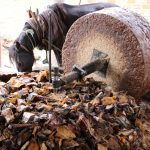It’s Coming: Holy Smoke! It’s Mezcal! The Revised 2nd Edition
I don’t know if you are excited, but I sure am! I have been working on the 2nd Edition of Holy Smoke! It’s Mezcal! for the better part of 2017, and I am finally getting close to publishing it. While I did not expect it to take this long, it turned out I had a lot to say!
So much has changed since the first printing of Holy Smoke! in the summer of 2014 – new brands, new regulations, new agaves, and I have learned so much as well. As I said then, mezcal cannot be mastered, and as I have continued to pursue this passionate hobby, my accumulated knowledge keeps expanding. I have more to say, more pictures to share, more stories to tell and hopefully a bit more good humor to entertain.

The Revised 2nd Edition is not a complete rewrite, so do not go in expecting that. But I have touched every chapter, written new chapters, combined old ones, and eliminated a few as well. There is more depth and granularity on all things mezcal.
As you may know, the last year or so has brought a few more books on mezcal, and I think a couple of them are very good. I also think one of the better ones took a few key concepts or points from Holy Smoke! without giving me credit, which is too bad. But I have moved on and tried to write the most in-depth book on mezcal that exists. My book is not for everyone – for example, vodka lovers may feel slighted. But if you want to know as much about mezcal as possible, I think The Revised Second Edition is the book for you. Mezcal and agave nerds stand by!
In the first edition, I really dug into the production process. Here, I went even deeper. I also added a new chapter, “Process Trumps Varietal”. In this chapter, I am bringing forth the concept that the process a mezcalero uses to produce his mezcal can almost always make the varietal indistinguishable. He is a sample from that chapter:
Typically, in mezcal production, the mezcalero only keeps the corazon from the first distillation. There may be other uses for the heads and the tails, but they are set aside. Then the heart of the first distillation is put back into the still for the second distillation. The second distillation is further cut into puntas, corazon, and colas, with the middle distillate being the highest quality alcohol, and this is the mezcal which is bottled. But what if the mezcalero makes an early cut on the puntas – meaning, some of the puntas become part of the corazon? Or what if he makes a late cut on the tails, which brings some of the tail into the corazon? Do you think that impacts the taste? You bet. Let’s see why.
All the vapors coming off the still have congeners. Congeners are substances that are produced during fermentation which are released by the heat of distillation. They are impurities, but they have flavor. The positive characteristics of a spirit are usually associated with a class of congeners called esters, which can bring apple, banana, mango, butter, anise, apricot and other tastes and smells to a spirit. The negative characteristics of congeners can bring odors and flavors such as nail polish remover, rubber, and rotten fruit. The names of some of these congeners are a bit scary: acetone, methanol, isobutanol, amyl alcohol, and ethyl butyrate to name a few. Amyl alcohol is often cited as the chief culprit in a hangover. But all these congeners are present in low, non-toxic, doses in almost any alcohol you drink. If you drank all the puntas or all the colas, you’d likely be in bad shape. But slices of either can be very beneficial to the mezcal. The distiller’s magic is to minimize the less desirable congeners and enhance the good ones.
Why am I telling you all this? Why should you care? When you bought a book on mezcal, you probably were not expecting a dissertation on the chemical process of distillation. I know, but stick with me – it’s about to come together.
So guess which part of the distillation primarily contains the esters? That’s rights. It’s the heart, or corazon. And guess which parts are dominated by the less desirable congeners? Right again. The puntas and the colas. So the taste of your mezcal is highly dependent on which congeners sneak in, and that process is controlled by where the mezcalero makes his cuts.
There is much before this excerpt and much after it as well, in this chapter. It is an important concept and maybe controversial too (I don’t mind stirring it up as you know), and a lot to expound upon at any rate. But this is just one small example of what I have tried to bring in the new edition: more depth, more analysis, more research, and more fun!
I have also added to the agave chart in the new version. As you may know, this chart details every unique agave from which mezcal can be made. I am up to 63 agaves now that I believe can make a unique mezcal! Over the years, I have received a lot of feedback from people who appreciate the research that went into that chapter as well as the result – many in the sprits industry tell me they use it as an ongoing reference. I love that, and now it is better and more refined. I even went nutty and alphabetized it.

I wish I could tell you this new version of Holy Smoke! would be out by Christmas, but sadly, it will not. While I have finished writing it, the editing and design process take time. So I hope to have it out in early 2018. I have not figured out to make this available on pre-order via Amazon, but I assure you I will let as many people as possible know when it is ready!
I think the Amazon price will be similar to the first edition, which admittedly is not cheap. But self-publishing a book with color pictures jacks up the publishing costs on every platform I have looked at. I use CreateSpace, because it is Amazon’s platform and they are the most efficient on everything for a self-published author, including price. On other platforms, the book would be priced north of $40, which is nuts. So you know, I make about $5 for every book sold no matter where Amazon chooses to sell it (usually $35). You can rightfully guess this is not really a money-making endeavor for me. On an hourly basis, I am sure Starbucks would be a better wage! But Starbucks is not a passion and mezcal is, so I don’t mind. I just want you to understand why the book costs what it does.
On that point, I am going to convert the first edition of Holy Smoke! into a black and white only version, and sell it at a much cheaper price. I think a lot is lost without color pictures, but at least that price point might be more accessible (the publishing costs fall dramatically when you go with black and white). People will have a choice and make their own decision.
There you have it. I am excited to be nearing the publishing date. If you buy it, I think you will enjoy it, and I will spread the word as soon as it is available. In the meantime, DRINK MEZCAL!


